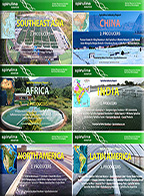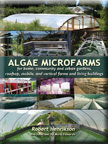Spirulina has been adopted by village farms in the developing world
As a supplement, spirulina offers remarkable benefits for undernourished people, especially children, with a long historical record of safe use. Taking just one to three grams per day, its rich beta-carotene can overcome eye problems caused by Vitamin A deficiency. Its digestible and very high 65% protein, B-vitamin complex, iron and trace minerals, improves a deficient diet and children’s physical and cognitive development. It is the only food source, except mother’s milk, with substantial GLA, an essential fatty acid that helps regulate the hormone system. There is a growing body of research with undernourished people showing how spirulina restores beneficial intestinal flora and strengthens the immune system.
Because spirulina can be cultivated in outdoor ponds with relatively little upfront investment, many initiatives have established village production using appropriate technology and available resources. Over the past 30 years, numerous projects have been growing spirulina as a local food in Africa, Asia and South America.
Here are brief stories of two of the pioneering projects and a sample from the many projects in Africa and Asia today.
The Integrated Village System in Farende, Togo. Parallel to the development of commercial production in the 1980s, Ripley and Denise Fox of France founded the non-profit Association Pour Combattre la Malnutrition par Algoculture (ACMA) to help fund the Integrated Health and Energy System, which recycled wastes already present in the villages for spirulina cultivation. They sponsored projects in India, Peru and Africa.
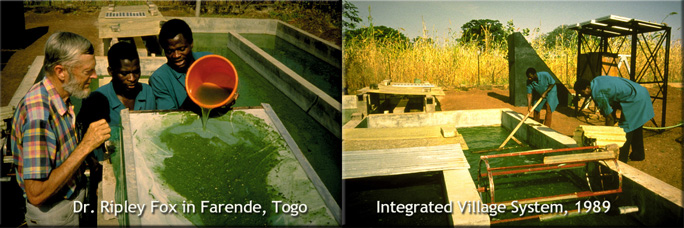
One experimental project was developed in a remote village in Northern Togo from 1984-1989. One 100m2 pond could supplement the diet of 100 children a day. Solar panels powered pond paddlewheels. Pond water was poured through a screen, becoming a paste, which was solar dried and distributed at the health clinic. Undernourished children took spirulina as a daily supplement. One tablespoon a day mixed with water brought remarkable results.
The Integrated Village System in Farende, Togo. 9:40 minute video of the village project developed by Dr. Ripley D. Fox (1989).
The design for the Integrated Health and Energy System won the prestigious 1987 European Award for Appropriate Environmental Technology, sponsored by the EEC and the UN Environmental Program. Modified versions were later adopted for projects in African countries, and small scale cultivation inspired a generation of French NGO workers who began the microfarm movement in France beginning about 2001.
Family scale cultivation in Tamil Nadu, India. In Southern India, a government sponsored project provided small backyard basins to women for family nutrition with the goal to develop into local village networks to combat Vitamin A and general immune deficiency conditions. In the 1990s, a joint effort by many government agencies covered all aspects of spirulina, from simple cultivation basins to large commercial farms. The government sponsored large scale nutrition studies with animals and humans and investigated therapeutic uses.
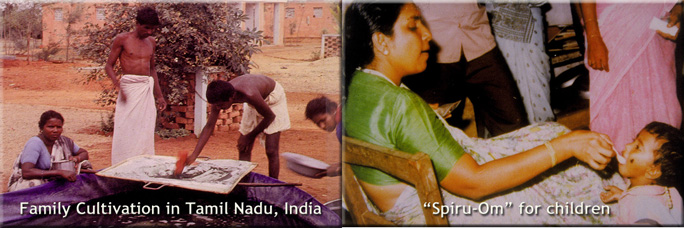
Spirulina was given to children in extruded noodles, sweetened with sugar to preserve beta carotene. Called “Spiru-Om,” it was well accepted by the children. This project was sponsored by the Indian government and was lead by Dr. C.V. Seshadri of the Murugappa Chettiar Research Center in Madras. As a result of these early efforts, there are numerous village projects across India today.

Antenna Technologies in Africa and Asia. Antenna was established in Geneva in 1989 by Denis von der Weid, promoting spirulina against malnutrition with a mission to make algae more affordable. Today Antenna Foundation in Switzerland (antenna.ch) is engaged in research and dissemination of technologies appropriate to the needs of the poor in developing countries. Antenna France (antenna-france.org) and its local partners set up spirulina production programs in African and Asian countries.
Antenna estimates pond installation costs between $15 and $30 per square meter and a pond of 200 square meters will produce enough spirulina for 1200 children per year, and will support a sustainable food supply chain and local employment and income, especially for women.
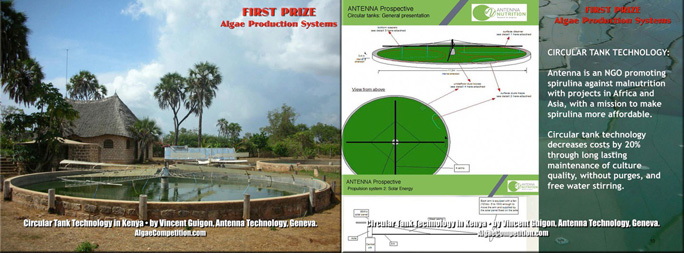
Antenna France has developed circular ponds to decrease costs. This project was awarded First Place Prize in the International Algae Competition for algae production.
Production technology is simple, with pond stirring by wind or solar devices or by hand. Spirulina is harvested by filtering through cloths and can be solar dried for preservation or the wet paste can be mixed directly into the staple diet.
Over the past decade, many technical problems have been resolved and product quality, packaging and diversity have been improved. Challenges are to replace imported inputs with local products and use recycling systems for growth nutrients to reduce costs. Establishing farms as businesses involves the engagement of local women, developing local distribution networks and educating people about nutritional benefits. The major challenge is to achieve financial sustainability.
Today there are farms in Burkina Faso, Cambodia, Laos, Madagascar, Mali, Mauritania, Niger, Central African Republic and India, and eight of these farms are running by themselves. In Cambodia, farms near Angkor Wat and Phnom-Penh are run by local families growing mushrooms and vegetables. In Mali, a farm is training students in spirulina and bee keeping. In Togo, a producer is extending his farm from 100 to 600m² to meet the strong demand. A nutrition house has been opened which will distribute spirulina to poor children.

Antenna Nutritech Foundation in Madurai, India (antennaindia.org) is a social enterprise devoted to providing everybody the necessary micronutrients for daily needs through fortified spirulina products. The first farm was launched in 1995 with one small basin at the fish farm campus. Technical support from Antenna Switzerland helped to enlarge the farm. Over the years, Antenna has trained people from NGO’s to grow spirulina in small farms all over India and Bangladesh.
To increase the number of people consuming spirulina, a marketing division developed new products. Today Antenna Nutritech Foundation is integrated from production to final product and reaches consumers through a strong network of NGOs distributors.

Green Tongue Candies were a finalist in the Algae Competition for food development.
Spirulina Tuttipakkam near Pondicherry was begun in 2007 as a collaboration between Volontariat of India (volontariat-inde.org) and Codégaz, linked to Gaz de France. The algae is grown in 4 tanks with an area of 250 m2. Production is 25 to 30 kg per month and it has 4 basins in greenhouses. Half is distributed to humanitarian associations, half is sold for economic self-sufficiency.
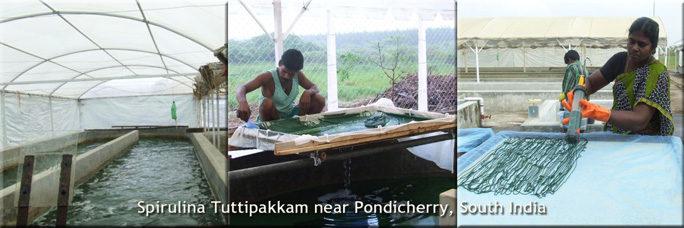
Burkina Faso has at least nine spirulina farms today (spirulineburkina.org). The first farm was launched in Koudougou in 1999 under the auspices of the Catholic Organisation for Development and Solidarity (OCADES). The three main objectives were 1) supply the diocese and other health centers in Burkina with spirulina against malnutrition, 2) sell a portion on the open market offering the public a food supplement at low cost, 3) create jobs at the farm.
The farm at Le Petite Seminaire expanded in stages to 900m2 and has been self financing since 2000. Its chief objective remains giving the public access to spirulina at a minimum price and distributing the product among the most destitute. It received Health Ministry approval in 2005.
By 2001, success of spirulina, measured by improvement in public health, led to increasing existing farms and setting up new ones with the assistance of non-governmental organizations to meet growing demand in Burkina and in the neighboring countries.
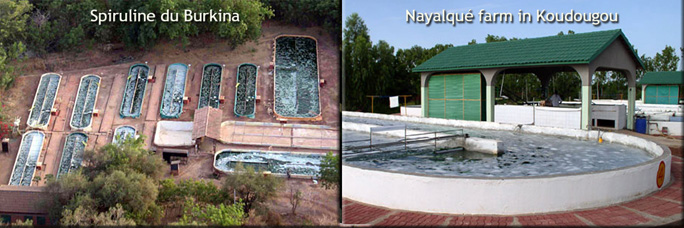
Nayalgué farm in Koudougou. The Burkina Government became involved in a large project, the Nayalgué farm, in co-operation with the diocese of Koudougou and the French NGO TECHNAP. Nayalgué, means “that which expands”. This farm has 3600m2 and a production capacity of 8 tons annually.

This large farm oversupplied the local spirulina market, leading to export production, in particular, to France. The present challenge is to increase exports to finance its humanitarian mission (45% is given or sold at humanitarian prices) and to be certified as fair-trade. Nayalgué claims to be a model farm in Africa as it is successful, locally managed, and easily visited by regional fact-finding missions.
Burkina Faso now has 9 farms or more, ranging from tiny 50m2 pools to the 3,600m2 Nayalgué Farm. Most farms are members of a national spirulina association, using standardized packaging and discussing issues on a monthly basis.
Next> Algaepreneurs and the microfarm movement in France
Small appropriate technology village farms in the developing world have led to the emerging movement of commercial algae microfarms, growing food products for local markets. Since many of these charitable organizations originated from France, microfarms in the developed world began in France, where there are now over 100 algaepreneurs.


